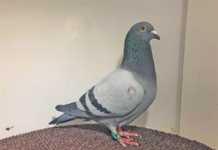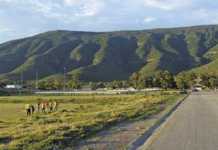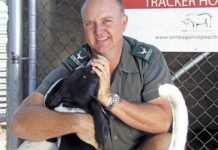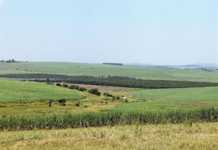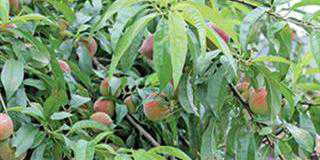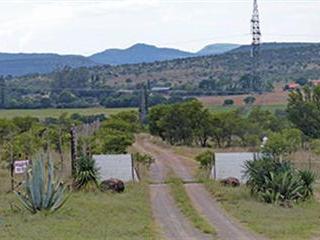
In early 1952, Ken Shuman (48) was battling to get an engine started along the Black Kei River when he suffered a severe heart attack and died. His wife, Edna, and then 16-year-old son, Hilson, were suddenly faced with the responsibility of farming Grey Craig.
An anglophile
Ken had famously met British King George VI and Queen Elizabeth during the royal visit to South Africa in 1947.
It was a foregone conclusion that Ken and his horse, Alfred, – Queenstown’s Five-Gaited Champion – would lead the cavalry procession to Queenstown during the royal visit. At the station, Ken broke protocol, dismounted and introduced himself to the royal family, including the Queen who took a great interest in Alfred.
.jpg)
Hilson Shuman (78) produced his 60th wool clip in 2013. The clip consisted of just over 50 bales.
“He said the King had little to say, but the Queen was no fool and very knowledgeable about horses,” Hilson recalls. “The questions she asked him about Alfred were amazing.” Hilson says Ken’s brush with the British crown had a profound effect on him. “He was very taken by the Queen and always said she was a gracious lady.”
Ken loved most things British and, for example, felt it was his duty to join the South African army to assist Britain in World War II, only to be sent back because he was too old. Ironically though, Ken had deep German roots. His great-grandfather, Wilhelm Shumann, left Germany for Africa in the 1850s under bizarre circumstances.
“When he was 15 years old, he [Wilhelm] threw a brick through a shop window in Hamburg,” explains Hilson. “He was so afraid of his father that he went down to the harbour and got a job on a ship destined for South Africa.” When the ship docked near present day East London in 1854, he made his way into the interior and eventually took a job offered by the Dicks family, a British settler family in the Waqu Valley between Cathcart and Queenstown.
He then married their daughter, Maria Dicks, and had a son who was not only given the English name of William (Hilson’s grandfather), but also sported a manipulated version of the family name – Shumann became Shuman, ostensibly to make it sound more English.
An inherited love of Merinos
When Ken bought Grey Craig from the Fletcher family in 1928, he believed that Merino sheep had the potential to bring untold wealth to ordinary farmers. In fact, he would often tell friends and family that a Merino’s hooves were lined with gold. Passionate about breeding top quality Merinos, he often went looking for rams at respected Karoo studs, including those owned by the Jordaan and Rubidge families near Cradock and Graaff-Reinet respectively. These trips would leave a lasting impression on Hilson.

Merino sheep have always been central to the Shuman’s agricultural initiative on Grey Craig. Hilson recently purchased these rams from the Droogfontein Merino Stud owned by the Sauer family in the Jamestown district of the Eastern Cape.
“When I was a kid, my father didn’t have a bakkie. We used to take the back seats out of the old motor car and go to the Karoo to load two rams. I enjoyed that annual trip very much,” he recalls. Then in 1950, Ken’s prediction about Merinos became a reality when a major wool boom brought unthinkable wealth to sheep farmers. Hilson vividly remembers the day the prices were phoned through from East London. He tells of how his mother sent him to read them out to his father, who was working on a nearby windmill.
“I went to the windmill and read out the prices and he told me to go back home and tell my mother we were wealthy,” Hilson recalls. Sadly, by 1952, his father’s life had been cut short and Hilson was faced with the tough reality of selling large numbers of livestock to cover death duties. In that year, he only managed to market 18 bales of wool, a number he had increased a great deal by the 1970s when he produced his biggest wool clip of 96 bales. Today, he still produces just over 50 bales.
After objective measurement became part of the wool industry in the early 1970s, Hilson was shocked to discover that Grey Craig wool was not nearly as fine as he had once thought, and promptly introduced Letelle rams to the flock. “I thought we had fine wool and was surprised when it measured 22 microns to 23 microns, “he recalls. “Thanks to Letelle rams, in one generation the microns decreased to 18 to 19.” Since then, he has continued to purchase Merino rams from various studs, including the fine wool studs owned by the Austen (Grahamstown) and Van Aardt families (Cookhouse). “My sheep are like the League of Nations. They come from different breeders,” he quips.
Unique Afrikaners
Ken farmed with Africander (Afrikaner) cattle mainly because of the rough stony veld. “He used to say when God made South Africa, he had some stones left over and poured them out here,” recalls Hilson with a chuckle. “He said they (Afrikaner cattle) had hard feet and could climb mountains.” The first of many bulls (Rio Grande) to set foot on Grey Craig was bought from the Pringle family in the Bedford district. But it was Hilson who decided to register a herd of Afrikaner cows. He purchased 16 registered cows from Dodds Pringle in Bedford soon after his father’s death.

The horns of Grey Craig’s most influential Afrikaner cow that was bought in 1952 for 25 pounds.
Interestingly, though it would be genetics produced by one 18-year-old cow – purchased from Morris Bradwell, also from Bedford, for 25 pounds (R50) in 1952 – that would eventually define the Shuman’s KS Africander Stud. From just two calves, this cow’s bloodline produced 33 of the 53 registered cows Hilson owned by the 1980s. Today, her horns adorn a small store room and are decorated by a number of agricultural show ribbons. Below them, a painting of the influential bull, Plan (the calf of her heifer calf) can be seen.
It was, however, a bull bought from a certain Nash Webber near Graaff-Reinet in 1948 that would have an unexpected impact on the Shumans’ herd of Afrikaners. To Ken’s horror, the bull produced calves with white markings and he told Webber his bull was a “baster” (Nash did supply another bull). The “throwing of colour” by the bull uncovered the fact that the ancestors of modern red Afrikaner cattle were the multi-coloured red, white and yellow cattle of the Khoikhoi pastoralists from whom early European farmers acquired cattle.
In time, these white farmers selected only red calves and so the genetic base for the future was laid. But Hilson secretly loved these Afrikaners and thought they looked as if they had “walked through milk”. He was often heartbroken when Ken culled them, so it is maybe not surprising that almost 20% of his now deregistered herd of about 90 Afrikaner cows are multi-coloured animals. “I already liked them as a kid. I think they are pretty and I favour them.”
As we drive back to the farm home – incidentally built by Ken – it is clear that Hilson is defined by Grey Craig and the unique agricultural way of life it has offered him and his wife, Isabel. When asked about his retirement plans, his answer is not surprising. “I love farming and animals. I am quite happy to farm and will only rest in the box,” he says with a broad smile.
Contact Hilson Shuman on 045 839 4913.

